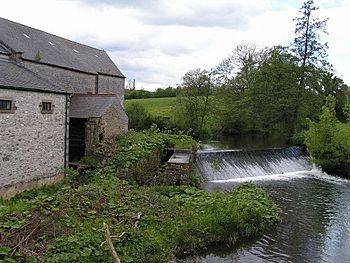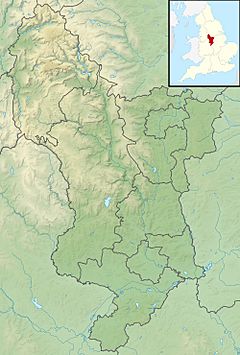River Noe facts for kids
Quick facts for kids River Noe |
|
|---|---|

This old watermill on the River Noe at Brough-on-Noe used the river's power. You can still see the waterwheel inside!
|
|
|
Where the River Noe joins the Derwent in Derbyshire
|
|
| Country | England |
| Counties | Derbyshire |
| Physical characteristics | |
| Main source | Edale Head, Kinder Scout, Derbyshire 53°22′55″N 1°52′44″W / 53.38182°N 1.87901°W |
| River mouth | Bamford, Derbyshire 53°20′21″N 1°41′39″W / 53.33929°N 1.69424°W |
| Length | 19 km (12 mi)adjusted length |
| Basin features | |
| Basin size | 73 km2 (28 sq mi) |
| Tributaries |
|
| Progression : Noe—Derwent—Trent—Humber | |
The River Noe is a river in Derbyshire, England. It flows into the River Derwent, which means it's a smaller river that joins a bigger one. The River Noe is about 12 miles (19 km) long.
It starts where two small streams meet. These streams flow down from Kinder Scout in the Peak District. From there, the River Noe flows east through a place called Edale. Then it goes southeast through the village of Hope.
The very beginning of the river, its source, is at Edale Head. From there, it flows down a narrow valley next to the Jacob's Ladder walking path. It continues through the beautiful Vale of Edale. The river eventually joins the River Derwent about one kilometer south of Bamford.
Interestingly, the entire length of the River Noe is followed very closely by the Hope Valley Line railway. This train line connects the cities of Manchester and Sheffield. The area downstream from Hope, including the valley of the River Noe's main smaller river, Peakshole Water, is known as the Hope Valley.
Contents
How the River Noe Was Used
Like many rivers in Derbyshire, the River Noe was very important in the past. People used its flowing water to power machines in watermills. These mills used big water wheels to do work.
Mills for Grinding Grain
Originally, most of the mills along the River Noe were corn mills. These mills were used to grind grain, like wheat, into flour. This flour was then used to make bread and other foods.
Mills During the Industrial Revolution
Later, during the time known as the Industrial Revolution, some of these mills were changed. They were rebuilt to do other kinds of work. This was a time when many new machines and factories were created.
Edale Cotton Mill
One example of a changed mill was the cotton mill in Edale. It was built in the late 1700s. This mill looked similar to other mills from that time. It had many floors with large windows and a roof that was not very steep.
Hope Corn and Saw Mill
In the village of Hope, there was another mill. This one was a corn mill and also a saw mill. A saw mill cuts wood. This mill was powered by a large water wheel that was 11 feet tall.
Mills at Brough-on-Noe
At a place called Brough, several mills used the power of the River Noe. These included a mill that made lace thread and another cotton mill. There was also a corn mill there, which you can see in the picture at the top of this page.
The corn mill at Brough stopped using water power in 1954. This happened because the flow of the River Noe was reduced. Water was taken from the river upstream to help fill Ladybower Reservoir. This was done by the Derwent Valley Water Board.
Ancient History of the River Noe
The River Noe has been important for a very long time. The ancient Romans built a fort overlooking a bend in the River Noe at Brough. This fort was called Navio. The name "Brough" actually comes from an old English word that means "fort."


